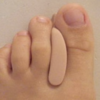Hallux valgus and osteopathy
What is hallux valgus?

Hallux valgus or "bunion" is a deformity, a lateral deviation of the big toe (called hallux) of the foot in relation to the first metatarsal. It is characterized by a prominence, a ball at the metacarpophalangeal joint of the big toe.
Epidemiology of hallux valgus
Hallux valgus is a very common foot deformity, affecting between 2 and 6% of the population. It is the most common deformity of the forefoot and is often associated with other pathologies. It appears in half of the cases around adolescence.
It is more common in women (1.5 men for every 10 women)
Factors that promote the appearance of hallux valgus
The genetics +++
75% is the genetic transmission rate of hallux valgus! Hereditary factors therefore play a major role in the development of this deformity.
Associated pathologies
Certain underlying diseases predominate the development of hallux valgus. Examples include:
- Rheumatic diseases
- The aftermath of a stroke
- Marfan syndrome
- Ehlers-Danlos disease
Heels:

Even if it is true that in the past, they have been given a large role, wrongly, in the development of hallux valgus, heels are still a factor in the development of this pathology because of the weight shift towards the forefoot and the narrowness of the tip of the shoe.
Types of hallux valgus:
Mild hallux valgus
Mild hallux valgus presents an angle between the axis of the 1st metatarsal and the axis of the 1st phalanx of the hallux of less than 20%.
Moderate hallux valgus
In moderate hallux valgus, the angle of deviation is between 20 and 40° and the patient has a metatarsophalangeal subluxation (between the phalanx and the 1st metatarsal).
Severe hallux valgus
Severe hallux valgus has a metatarsophalangeal angle greater than 40°. The patient presents a subluxation with the big toe passing over or under the second toe. This is very often painful and is associated with stiffness of the metatarsophalangeal joint.
Examinations for hallux valgus

The clinic (observation and palpation) makes the diagnosis, additional examinations can be considered to evaluate the importance of the deformity.
X-rays are a good examination, provided that they are performed in a weight-bearing position, i.e., standing up, in order to represent as much as possible the constraints of daily life.
The consequences of hallux valgus:
This modification of the foot architecture can be a source of :
- Tendinopathy
- Inflammation especially around the capsule that encloses the head of the first metatarsal and the base of the first phalanx of the hallux
- Osteoarthritis in the foot
- Appearance of calluses on the hallux
- Corns appear, especially on the second toe, due to the shoe and the fact that the second toe is pushed by the big toe
Treatment of hallux valgus
Night or day orthotics


The purpose of these restraints is to keep the hallux in line and prevent the deviation from worsening. It is not a direct treatment even if it often relieves the patient but it would limit the evolution.
There are night restraints but also small orthoses (or protective orthoplastics) that are almost invisible and can be worn during the day.
In addition, in cases of severe or moderate hallux valgus, deviations impacting the other toes may be present, these orthoses can be very effective.
Do not hesitate to contact your podiatrist about this.
Strapping or kinesio taping
The strapping will have the same role as orthoses and can be used to relieve the patient. For the long term, the orthesis is more recommended because it is less tedious, as it is not necessary to redo the strapping every two days. Moreover, if strapping is applied one after the other, there is a risk of allergy and skin intolerance. However, in the short term, strapping is useful to relieve pain.

Kinesiotaping is intended to guide the joint but also to relieve inflammation and pain. Applied from time to time, it brings comfort to the patient.
To be well shod
In cases of hallux valgus, it is advisable to have a pair of shoes with a flexible, wide forefoot to limit the compression of the toes.
Orthopedic inserts:
Orthopedic insoles will aim to relieve pain by relieving pressure (limiting stress) on the suffering areas. For example, insoles can reduce the pressure under the heads of the metatarsals by 2 to 3 times.
Surgery and hallux valgus?
Aesthetics is not a good motivation for surgery. In fact, post-operative complications are not rare...
Surgery should only be considered when the conservative treatment described above is not sufficient and the patient still has severe pain.
There are many operations (osteotomy, arthrodesis, etc).
Recovery is long and depends on the surgical method used; it takes 6 to 12 weeks before mobilization can be considered.
Even if the operation goes well, a stiffness of the metatarsophalangeal joint will be present which can be very disabling for an athlete. Athletes must be particularly vigilant in their choice of surgery and have tried everything beforehand.
Osteopathy and hallux valgus

Osteopathy does not directly treat the deviation of the hallyx valgus. But it aims, by working on the metatarsal-phalangeal joint as well as on all the surrounding structures (muscles, fascias, etc.), to relieve or even remove the patient's pain.
By mobilizing the area, the osteopath will be able to restore flexibility to the joint which will improve the patient's comfort but also limit the risk of repercussions on the rest of the body.
The practitioner will also treat any imbalances in the rest of the body that may be contributing to the tension in the foot or caused by the asymmetry of the foot.
Finally, your osteopath will be able to apply a strapping or kinesio taping to relieve the patient as much as possible and give advice to the patient (foot muscular exercises, heating, etc.) or redirect you to another professional for an efficient multidisciplinary management.
Marie Messager
Osteopath D.O
2 rue Alexis de Tocqueville
78000 Versailles
